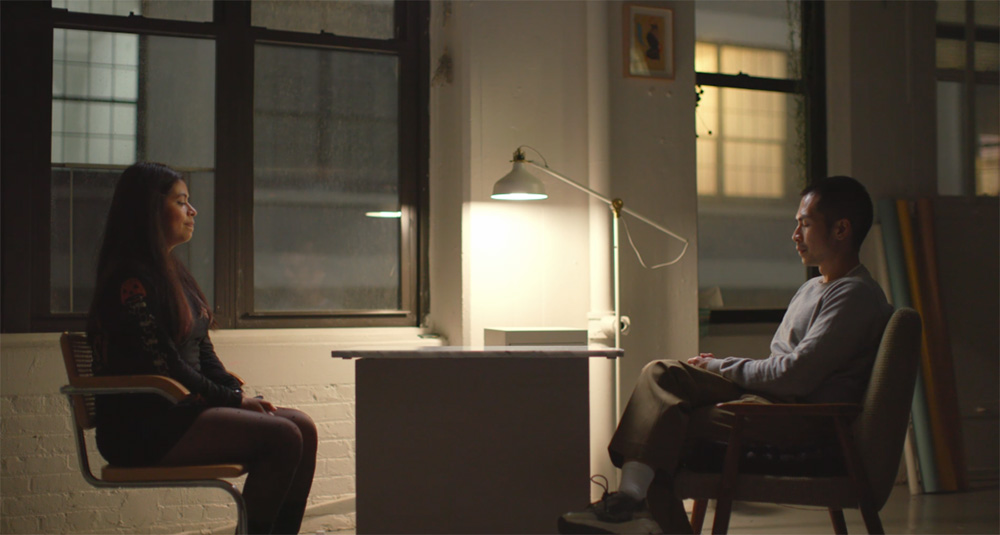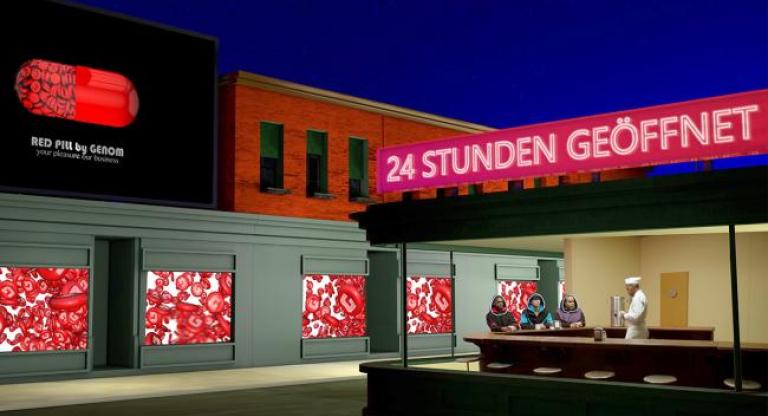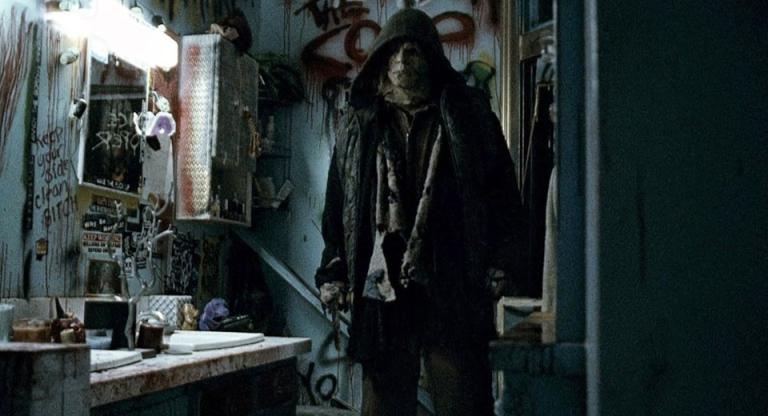A few weeks ago, I entered Brooklyn’s Green-Wood Cemetery at dusk for an advance screening of Lana Wilson’s latest documentary, Look Into My Eyes (2024). Surrounded by approximately 600,000 of my deceased neighbors, the ambience was ideal for taking in this moving exploration into the practices and private lives of seven psychic mediums.
Wilson isn’t one to shy away from complex interview subjects. From the few remaining doctors who perform third trimester abortions in the United States (After Tiller, 2013) to Taylor Swift (Miss Americana, 2020), she approaches incredibly unique lives with nuance and compassion, using such intimate portraits to raise larger questions about life, death, and how people need one another in order to navigate both. These qualities are similarly on display in Look Into My Eyes. The film drifts through in-depth sessions between psychics and the clients who come to them for answers—whether they be about deceased loved ones, future romantic partners, or even the inner-thoughts of their pets. As we become better acquainted with the psychics, we see people who are simultaneously trying to use what skills they have to stay afloat in New York City (and such skills just happen to involve talking to spirits) while attempting to help others heal from trauma and loss, trying to find closure for their own deep wounds.
Wilson makes no attempt to prove or deny the verity of clairvoyance—she is far more interested in the affective impact that is conjured within the psychic session. One fascinating similarity among most of the psychics included in the film is their creative interests—there are a couple cinephiles in the group—and experience in the performing arts. It becomes clear, however, that performativity is not a tool wielded disingenuously to lure in customers, but rather the essential framework that makes the session an emotionally cathartic experience for the client and the psychic. Whether or not these people are actually able to connect with another plane, they do possess a special skill: one that heals people, or at least helps them take the first step in accessing the emotions they need in order to move on.
I spoke with Wilson about how she selected such a compelling group of psychics, the role that New York City plays in the film, and how psychics and cinema cast similar spells. Our conversation has been edited for length and clarity.
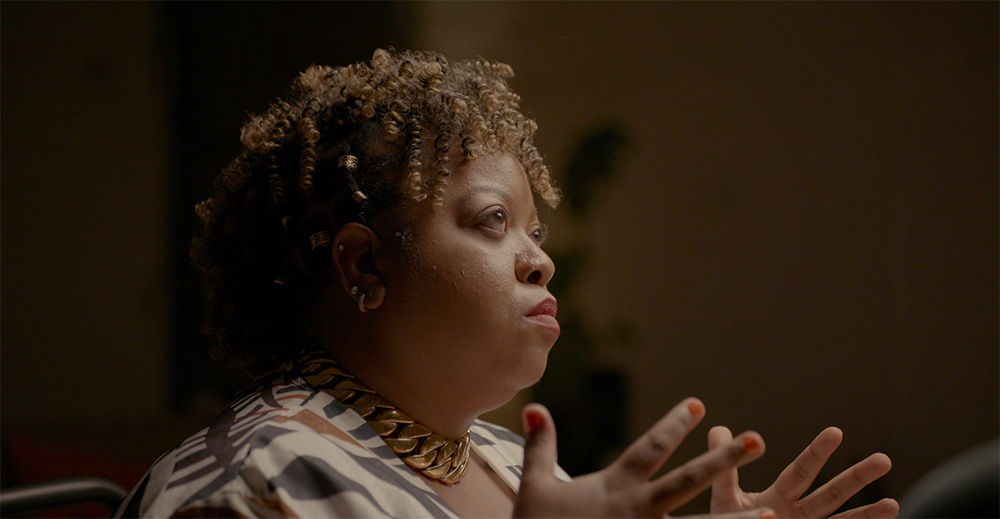
Stephanie Monohan: I had a pretty magical experience seeing this film at the Green-Wood Cemetery. It felt like the sort of space where people might open themselves up more to the ideas in the film because of the environment. It kind of resembled a session with a medium because you’re in a place that feels so charged with ideas around death and the afterlife, so you can let your skepticism drift away a little bit.
Lana Wilson: You know, the French word for a theatrical film screening is “séance.” There’s something extra special about the cemetery, but that always exists in a movie theater. There’s this ritualistic aspect to coming in, being there, connecting to these strangers that you see on screen. The experience of that can be both contrived and real at the same time. Even if you’re watching a fiction film, the emotional experience is real. Sometimes going to see a movie in a theater or seeing a play can actually feel more real and more vivid than real life. Psychic sessions can also be an extra vivid way of looking at yourself and your life because of the setting that it’s in.
SM: You had an interaction of your own with a psychic before deciding to make this film. How much skepticism did you have when you began production? Or were you more open to what you might find along the way?
LW: I think I entered with full skepticism. I had never taken the psychic tradition seriously in any way; I saw it as a kind of trivial thing. When I went to a psychic for the first time, I was really surprised that I found comfort in it. I was struck by how it wasn’t so much about whether I believed in what the psychic said or not—I don’t even remember what she said. I just remember that I felt a little bit better afterwards.
I thought, “I wonder what the difference is between me and the millions of people around the world who are seeing psychics every year? What is the difference between those people and the psychics themselves?” It’s not unlike other religious belief systems in that it’s a template for understanding and finding meaning in a world that, on the surface, makes no sense at all. Not unlike religious belief systems, you might believe in things that can’t be proven. But it’s not so much about believing or not believing, it’s more about the meaning that these interactions give us.
SM: I know you went through a lengthy process of narrowing down which psychics you chose to focus on in the film. Were you looking for certain qualities in the psychics themselves? Were you looking to represent a diverse range of practices or approaches?
LW: We talked to almost 150 different psychics. We would book sessions with them but wouldn’t say we were making a documentary and looking for people to be in it. I was looking for people, first and foremost, who were genuine and sincere about what they were doing. You can agree or disagree whether what they’re saying is “real” or not, but I wanted people who were genuinely seeking a connection to something bigger than themselves and who were wanting to help the people who come to see them. I can understand why some people don’t like psychics, because there certainly are those who just want to make as much money as possible, who exploit vulnerable people, and who, I think, are disingenuous about what they’re doing. None of those people are in this movie.
I was looking for people who would be open about their own doubts and questions about doing this work, and who were willing to explore all of that. I also wanted people who did longer deep-dive sessions, not the quick dry kinds of sessions that I got from almost every storefront psychic. I was looking for slightly different approaches, but this group actually has more in common in their styles than compared to psychics in general. As I got to know them, I learned that many of them were cinephiles and aspiring creative people. Many of them had theater or performance backgrounds. That was really interesting to me and made sense in a way since there is an aspect of performance in this work. It doesn’t mean they’re not being genuine—something can be artificial and also real. Something can be constructed, like a work of art is, but can also connect to you and be transformative.
Most of these psychics had a loss that was formative for them that they are still processing. I really wanted the second half of the film to be about how we process grief and loss, and how psychic sessions are one way of doing that. In this case, the healer is doing that as much as the person seeking healing. There’s so much connective tissue between all of them that it enabled me to make a film that has no main character, no obvious story, but you can move from one scene to another and bring a charge from one scene into the next with a different person.
SM: I imagine piecing together these sessions into a whole film was quite the process.
LW: It's a film that is very much about the cumulative effect. It was by far the most difficult film I've ever edited. In part because there’s no main character, but also because I wanted it to have this really particular shape where it started with the clients and gradually got broader and broader in its scope, and then ended with the psychics in a kind of table-turning mirroring shape.
It's a very slow, deliberate, and meticulous reveal that the psychics are the main characters of the film. It’s challenging and it requires a lot of patience on the part of viewers. While editing it, because it's so much about the build and the charge that's carried over from one scene to the next, and the gradual widening scope of the film, any change we would make in the film could not be evaluated on its own. I couldn’t watch anything out of context; I had to watch from the beginning up until that point to be able to know how it felt.
SM: I think that cumulative effect you describe is very successful. The first session really draws you in and then each subsequent one does the same—it’s easy to almost get hypnotized. When it shifts to focusing on the psychics’ lives it feels like a real left turn. Can you talk about how you approached that shift?
LW: I always wanted that to be a really shocking moment. The way the sessions were filmed was inspired by the Hirokazu Kore-eda movie After Life [1998]. The clients in that film are filmed in these lockdown compositions, kind of like my Zoom screen now. After some experimenting at the beginning I found that for me, that was the best way to film the sessions because it had a neutrality and austerity to it.
I tried to film the sessions handheld once and it felt incredibly manipulative when I watched the footage back because the handheld [camerawork] indicates it’s a documentary—it’s real. In this context that felt manipulative, so locking down that composition and having the exact same composition for every single client brought more of a neutrality to it. It also gives the audience the space to just focus on the feelings and thoughts running across people’s faces—to observe them in this unique way.
I thought of that transition to the psychics as moving from After Life to suddenly being in the movie Keane [2004]—all of a sudden you’re in the subway and it’s gritty, it’s loud, it’s shitty New York. It’s only two slightly different visual styles, really, but it feels quite shocking in the context of the film to go from tripod to hand-held camera. We move from the quiet sessions to being in the outside world and in the psychics’ apartments where there’s stuff everywhere—the boom is getting in the shot and there’s an intentional messiness to the style. It’s like the chaos of the real world feels intrusive and very different from the orderliness of the sessions.
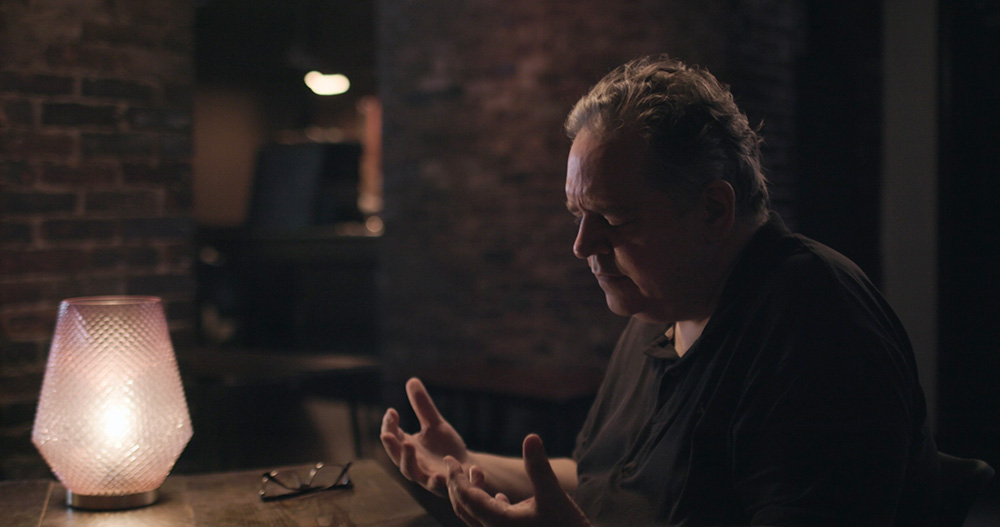
SM: In the sessions, how did you orchestrate the filming so that you were so intimately locked in with the psychic and the client, while also minimizing the impact that the presence of the camera and crew would have on the session itself?
LW: I mostly make films that have observational footage in them and that's always the thing: how to get material where people are not self-conscious or performative on camera. It's becoming increasingly difficult, especially with younger people, as iPhones are ubiquitous and as we film each other and ourselves more and more.
The ideal is that the client doesn't see anyone except for the psychic, so we put a camera on a tripod right behind the psychic’s shoulder, which is filming the lockdown composition of the client. But the camera is unmanned. I had someone pulling focus remotely in another room. Also, it’s a small camera and the session is so intense the client is pretty focused on the psychic. The camera becomes like a piece of furniture that's just there. I’m hidden in another room or behind a curtain or something—no one sees me and no one sees the sound recordist.
There is a cinematographer in the room, usually it was Stephen Maing, and he would be behind and to the side of the client, filming the psychic in 45-degree profile shots outside of the client’s eyeline. With cinematographers, it’s not just about how they shoot, It’s about their physical presence in the room—it affects everything.
Steve is amazing because he’s just an incredibly grounded, warm presence. People feel very comfortable around him. We came up with an approach where he would only move two or three times during an hour-long session, so he’s pretty much completely still and quiet. We carefully designed it to make both people feel as much as they could like they were alone and really locked into each other.
SM: I really wanted to ask you about one session in particular, which is the one with the ER doctor, which bookends the film. It’s kind of shocking—it really hooks the viewer and draws them into the world of the psychics. Did you always envision using one session to open and close the film? If so, how did you select this interaction as what would set the course for the film?
LW: I had started working a little bit with my editor before we filmed that session with the doctor, and we knew we had to find the right session to open with. We realized that it had to open with a story or a question that would not be asked of a therapist, because when the film opens you see that shot of the client and think, “Is this a documentary interview? Is she an expert? Is this a therapy session?” But her question at the end of her story indicates it is not a therapy session; there’s something supernatural about it.
As soon as we filmed with that doctor, I knew that was the opening line of the film—also because she was an unexpected person to be visiting a psychic. She’s a doctor, she went to medical school; I don’t think that you would assume that someone with the scientific or medical background she has is going to be seeking psychics. She’s also a healer in need of healing, which is one of the themes of the film. She didn’t have a way of processing this seemingly meaningless, horrific event, and hasn’t found any way of moving forward after experiencing that, so she’s come here.
The bookending idea came as we edited. There was something about their hug that I found so powerful, because it felt like two desperate people clinging to a lifeboat together. There’s a really profound need there and you start to have all these other emotions while you’re watching because of the length and intensity of the hug.
I thought Nikenya said so many things to her that were thematically right for the ending of the film: “This is the grieving out loud.” To me that’s the entire film. We can grieve out loud in different ways: with a therapist, with a religious leader, in a cinema, at a performance—we need to grieve out loud as humans.
SM: Another particularly compelling scene was the one where all the psychics are together and they’re performing medium work for one another. It addresses a question that you ask of them in the film, which is: “who heals the healer?” But also, for anyone who goes into the film with a lot of skepticism, it shows the viewer how real this is for the psychics themselves. Could you talk about the thoughts behind this segment?
LW: This group I ended up with—a few of them knew each other already—is a small community in New York and I gravitated toward people with a similar style in some ways. Three of them had already participated in these monthly séances together. So there was an existing séance that was happening regularly and I basically just asked if it was okay that I bring the other people there to participate. It was funny because a couple of them realized, when they met, that they had gone to the same acting school. I think that Phoebe had done a reading for Michael’s pet once. There were all these connections because that world is so small.
That moment with Per, the psychic who is trying to connect to his friend Alex, who has passed on, stood out to me so much because he’s just being so vulnerable and totally genuine. I think you’re so with him at that moment of feeling how much he wants that connection and comfort and to retain, in some way, this relationship with his friend who is so, so important to him. And again, it’s not about whether Alex is really there or not; it’s about these people who are supporting him in this moment of pain and vulnerability where he asked for help and they lean in to support him. It was just incredibly moving to me.
SM: This film does a great job at portraying the work of being a psychic. Perhaps because of the metaphysical nature, people don’t often think of it as work. But here we see the performance side of the job, such as Sherrie navigating parties that she’s hired to attend, but then there’s the therapeutic side of the job and the intense emotional labor that goes into it. Is there something that you were trying to demystify about the job of a psychic or trying to convey to people who might underestimate that this is a real form of labor?
LW: I think there is this stereotype that psychics are financially exploiting people, and again, those are not the people in my movie so I can’t really speak for psychics at large. I mainly wanted to hone in on a group of people who were genuine and not trying to exploit people, and then look at them as human beings. I think you’ll see that there’s a reason this existed for millions of years, way before therapy was invented, way before the English language was invented. There is something about humans connecting to each other and the magic you can feel when you connect to a person, whether it's through psychic readings, conversation, art, performance, whatever. It feels like magic when we feel seen by someone else. This is something that AI will not replace—it’s always going to be here.
SM: I think that really intertwines with how New York this film is. There's a very contradictory blend of intimacy and anonymity in New York City where you can have a brief, extremely intimate psychic session with someone who you may never see again, but you share this significant connection with them. It’s like how New York is the one place where you can cry in public without being judged for it or treated strangely. It’s a rich setting for this type of psychic work. How big of a role did New York play in your initial conception of the film? Did other parts of the city emerge for you while you were in production?
LW: It was always a New York movie. I’ve lived here for 20 years and I was here during the whole pandemic. When lockdown began, everyone was so isolated, lonely, frightened, and anxious about the future, but also realizing the preciousness of in-person connection more than ever.
I think people were, in my experience, really there for each other in these surprising ways. During the pandemic, I was doing mutual aid grocery deliveries and many of the people working with me were nurses. They were working in hospitals during the day and then in their free time were doing grocery deliveries. I remember thinking that there’s nowhere else I’d want to be during this kind of collective global trauma because, oddly, I felt safe here. Even though it was a huge site of death and loss, people were trying to help each other and you weren’t completely isolated.
I also think about the fact that the people I ended up being drawn to for this film had these show business dreams and were hustlers. Every New Yorker has a day job and also is writing screenplays or wants to start a one-woman show; that’s such a New Yorker thing. I think it’s also a city where it’s okay to be lonely.
People are not moving to New York to pursue a conventional family structure—that’s not what brings us here. So I loved how the psychics in this film reflected that, too. They’re alone, their apartments are small and filled with tributes to all of their favorite art, that’s true for all of us. It’s funny because you hardly ever see New York in an external way in the film, it’s almost entirely interior. There are a few very carefully-selected and placed exterior shots of New York City, but almost none. I think the interiority is what New York is all about, the people themselves and their stories and their questions.
Look Into My Eyes screens on Wednesday, October 16, at the Roxie, with director Lana Wilson in person.
Previously:
Look Into My Eyes screens September 5-11 at Film Forum. Director Lana Wilson will be in attendance for a Q&A throughout this weekend.
Look Into My Eyes opens Friday, September 13, at the Roxie and plays through the following week.
